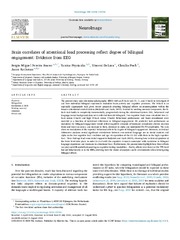Brain Correlates of Attentional Load Processing Reflect Degree of Bilingual Engagement: Evidence from EEG
Permanent link
https://hdl.handle.net/10037/34438Date
2024-08-13Type
Journal articleTidsskriftartikkel
Peer reviewed
Author
Soares, Sergio Miguel Pereira; Prystauka, Yanina; Deluca, Vincent Francesco; Poch, Claudia; Rothman, JasonAbstract
The present study uses electroencephalography (EEG) with an N-back task (0-, 1-, and 2-back) to investigate if and how individual bilingual experiences modulate brain activity and cognitive processes. The N-back is an especially appropriate task given recent proposals situating bilingual effects on neurocognition within the broader attentional control system (Bialystok and Craik, 2022). Beyond its working memory component, the N-Back task builds in complexity incrementally, progressively taxing the attentional system. EEG, behavioral and language/social background data were collected from 60 bilinguals. Two cognitive loads were calculated: low (1-back minus 0-back) and high (2-back minus 0-back). Behavioral performance and brain recruitment were modeled as a function of individual differences in bilingual engagement. We predicted task performance as modulated by bilingual engagement would reflect cognitive demands of increased complexity: slower reaction times and lower accuracy, and increase in theta, decrease in alpha and modulated N2/P3 amplitudes. The data show no modulation of the expected behavioral effects by degree of bilingual engagement. However, individual differences analyses reveal significant correlations between non-societal language use in Social contexts and alpha in the low cognitive load condition and age of acquisition of the L2/2L1 with theta in the high cognitive load. These findings lend some initial support to Bialystok and Craik (2022), showing how certain adaptations at the brain level take place in order to deal with the cognitive demands associated with variations in bilingual language experience and increases in attentional load. Furthermore, the present data highlight how these effects can play out differentially depending on cognitive testing/modalities – that is, effects were found at the TFR level but not behaviorally or in the ERPs, showing how the choice of analysis can be deterministic when investigating bilingual effects.
Publisher
ElsevierCitation
Soares, Prystauka, Deluca, Poch, Rothman. Brain Correlates of Attentional Load Processing Reflect Degree of Bilingual Engagement: Evidence from EEG. NeuroImage. 2024Metadata
Show full item recordCollections
Copyright 2024 The Author(s)


 English
English norsk
norsk
